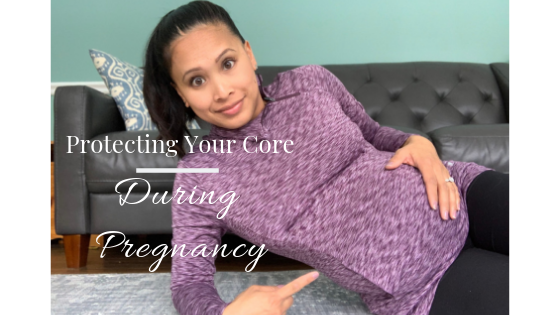As women get into the second half of pregnancy, their bumps are growing at a rapid rate. It can get a little more difficult to move around with a watermelon as a belly. The abdominal muscles are stretching significantly and can sometimes separate at the midline, known as Diastasis Recti Abdominis. This condition affects approximately 66% of women in their third trimester and 55% of women in the postpartum period. At times it will resolve itself with natural healing after delivery, but often requires training to regain optimal functioning. Here are techniques and tips to protect your core during pregnancy and decrease the risk of diastasis recti.
Protecting your core
Start with the diaphragm! Breathing properly is key for your core and pelvic floor.
Believe it or not, most people do not breathe efficiently and often engage in shallow chest breathing instead of deep “belly-breathing”. Diaphragmatic breathing or “belly-breathing” is a technique that some yogis may be familiar with. It has multiple benefits, especially for prenatal and postpartum moms. Not only does diaphragmatic breathing engage your core, but also reduces tension all over the body, decreases anxiety, and promotes healing.
- Lie on your back in bed with your knees bent, or if in the later stage of pregnancy, sit up with straight posture. You can use a pillow under your head and your knees for support, if that’s more comfortable.
- Place one hand on your upper chest and the other on your belly, just below your rib cage.
- Breathe in slowly through your nose, letting the air in deeply, towards your lower belly. The hand on your chest should remain still, while the one on your belly should rise.
- Tighten your abdominal muscles and let them fall inward as you exhale through pursed lips. The hand on your belly should move down to its original position.
- Repeat 10 times

Engage the deep abdominal muscles
Your abdomen is made up of a group of superficial and deep muscles, all which work to help you move, stand still, balance, protect your organs and spine etc. When you are pregnant, these muscles are working overtime to accommodate the increasing weight of the baby but also keep you functional. How do we find those deep muscles?
- Stand against a wall or sit upright, place your hands at your hips and move inward under your belly as if you’re stuffing your hands in your pockets. Cough to feel those muscles (transverse abdominis) contract to know that you have found them.
- Take a deep diaphragmatic breath in, as you just learned from the steps above.
- As you exhale, draw your belly button in towards your spine and feel those muscles contract.
- Repeat 5-10 times, making sure to keep a nice rounded shape (no coning or tenting at your belly)

This is what coning or tenting looks like:

Activate before you move
After the halfway point in pregnancy, or even prior to it, you should avoid doing full sit-up from the lying position or going from sitting to lying flat on your back without support. Instead:
- use your hands behind you to support yourself as you lower, or better yet, bend your knees and roll to get in/out of bed.
- Always contract those deep ab muscles before you move.
- Do not hold your breath, exhale as you move
Wear a maternity support band
Towards the later stage of pregnancy, which may be in the 2nd or 3rd trimester, wearing a belly band can help protect your core and also provide support to your low back. There are many different bands out there on the market. Finding something comfortable that can be worn under your clothing is what is key.
We will talk more about on addressing DRA/Diastasis Recti after delivery and into the postpartum period. Just stay tuned!!



